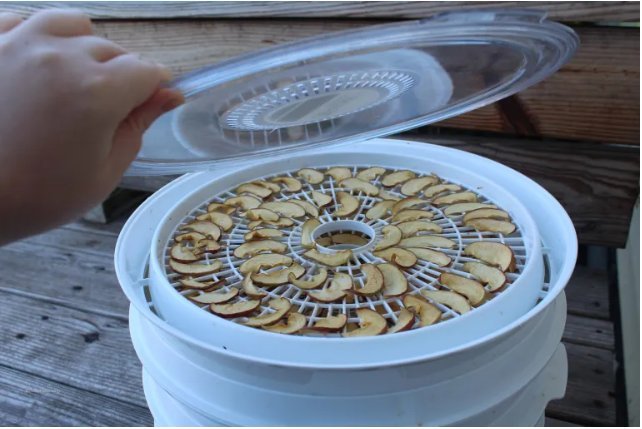How to Dehydrate Apples: A Step-by-Step Guide
Dehydrating apples is a rewarding process that allows you to enjoy the delicious taste and nutritional benefits of apples year-round.

Dehydrating apples is a fantastic way to preserve their flavor and nutrition while extending their shelf life. This simple process transforms fresh apples into a versatile and healthy snack that you can enjoy year-round. Whether you're new to dehydrating or looking to refine your technique, this guide will provide you with everything you need to know about how to dehydrate apples successfully.
How to Dehydrate Apples?
Dehydrated apples offer numerous benefits beyond just a tasty treat. They retain much of their nutritional value, providing a good source of fiber, vitamins, and minerals. Because the moisture is removed, dried apples have a long shelf life and are easy to store, making them a convenient snack for travel, school lunches, or emergency food supplies. Additionally, dried apples can be used in a variety of culinary applications, from baking to savory dishes, adding a touch of natural sweetness and texture.
Choosing the Right Apples
Not all apples are created equal when it comes to dehydrating. Varieties like Fuji, Gala, Honeycrisp, and Granny Smith are particularly well-suited for drying due to their firm texture and balanced sweetness. When selecting apples, choose those that are fresh, ripe, and free from bruises or blemishes. Organic apples are a great choice if you're looking to avoid pesticides, but conventionally grown apples can also work well, especially if you peel them before dehydrating.
Preparing Apples for Dehydration
Preparation is key to achieving evenly dried apple slices. Start by thoroughly washing your apples to remove any dirt or wax. Depending on your preference, you can peel the apples or leave the skin on. Next, use an apple corer to remove the core and seeds. Slice the apples evenly, aiming for slices about 1/4 inch thick. This uniformity ensures that all slices dehydrate at the same rate. To prevent oxidation and browning, soak the apple slices in a solution of lemon juice and water (1:4 ratio) or use a commercial ascorbic acid solution for a few minutes before drying.
Methods How to Dehydrate Apples
There are several methods you can use to dehydrate apples, each with its own advantages and considerations.
Using a Dehydrator
A food dehydrator is one of the most efficient tools for dehydrating apples. Arrange the apple slices in a single layer on the dehydrator trays, ensuring they do not overlap. Set the dehydrator to a temperature of around 135°F (57°C) and let it run for 6-12 hours, depending on the thickness of the slices and the humidity level. Check the apples periodically for dryness; they should be pliable but not sticky or moist.
Using an Oven
If you don't have a dehydrator, an oven can also do the job. Preheat your oven to its lowest setting, typically around 140-170°F (60-75°C). Line baking sheets with parchment paper and place the apple slices in a single layer. Leave the oven door slightly ajar to allow moisture to escape and bake the apples for 6-10 hours, turning them occasionally to ensure even drying. The key is low and slow to avoid burning the apples.
Sun Drying
Sun drying is a traditional method that works best in hot, dry climates. Place the apple slices on a clean drying rack or mesh screen, ensuring they are not touching. Cover them with a thin cloth to protect from insects and place them in direct sunlight. This method can take several days, depending on the weather conditions. Bring the apples indoors at night to prevent moisture from settling on them.
Storing Dried Apples
Proper storage is essential to maintain the quality of your dried apples. Once fully dehydrated, let the apple slices cool completely before transferring them to airtight containers, vacuum-sealed bags, or glass jars. Keep them out of direct sunlight and dampness by keeping them in a cool, dark spot. When stored correctly, dried apples can last for up to a year.
Creative Uses for Dried Apples
Dried apples are incredibly versatile and can be used in numerous ways. Enjoy them as a healthy snack on their own or mix them into trail mix for added sweetness. They are excellent in baking, adding flavor and texture to muffins, breads, and cakes. You can also rehydrate dried apples by soaking them in warm water for a few minutes, making them suitable for use in recipes that call for fresh apples. Try adding rehydrated apples to oatmeal, salads, or savory dishes like pork roast for a delicious twist.
Conclusion
Dehydrating apples is a rewarding process that allows you to enjoy the delicious taste and nutritional benefits of apples year-round. With the right preparation and method, you can create perfectly dried apple slices that are both tasty and long-lasting. Give it a try and discover the many ways you can incorporate dried apples into your diet and recipes.
FAQs
How to Dehydrate Apples without peeling them?
Yes, leaving the peel on can add extra fiber and nutrients.
How do I know when the apples are fully dried?
They should be leathery and pliable but not sticky or moist.
Can I use flavored solutions for soaking?
Yes, adding cinnamon or other spices to the soaking solution can enhance the flavor of your dried apples.
What's Your Reaction?











![Wireless Connectivity Software Market Size, Share | Statistics [2032]](https://handyclassified.com/uploads/images/202404/image_100x75_661f3be896033.jpg)



